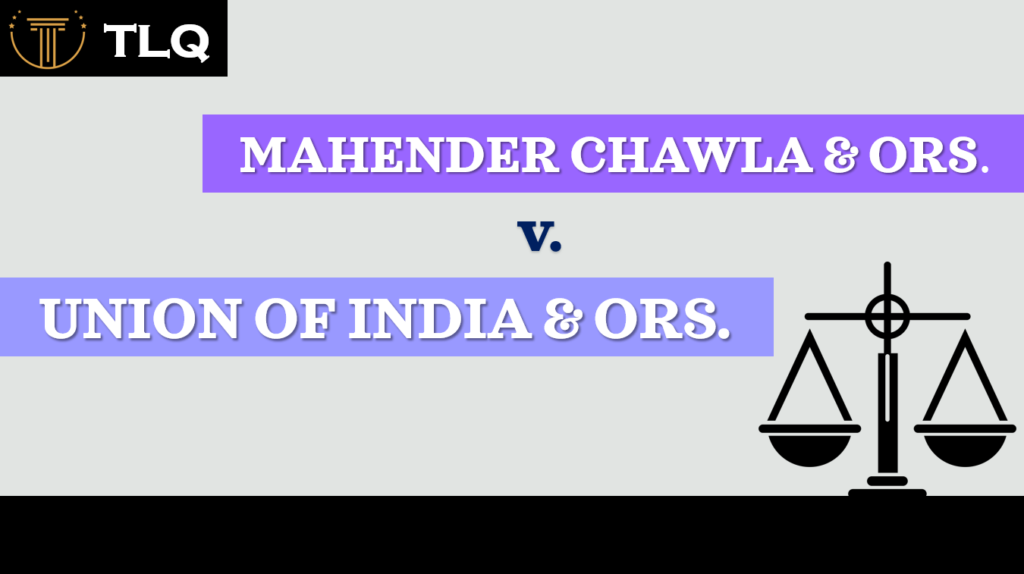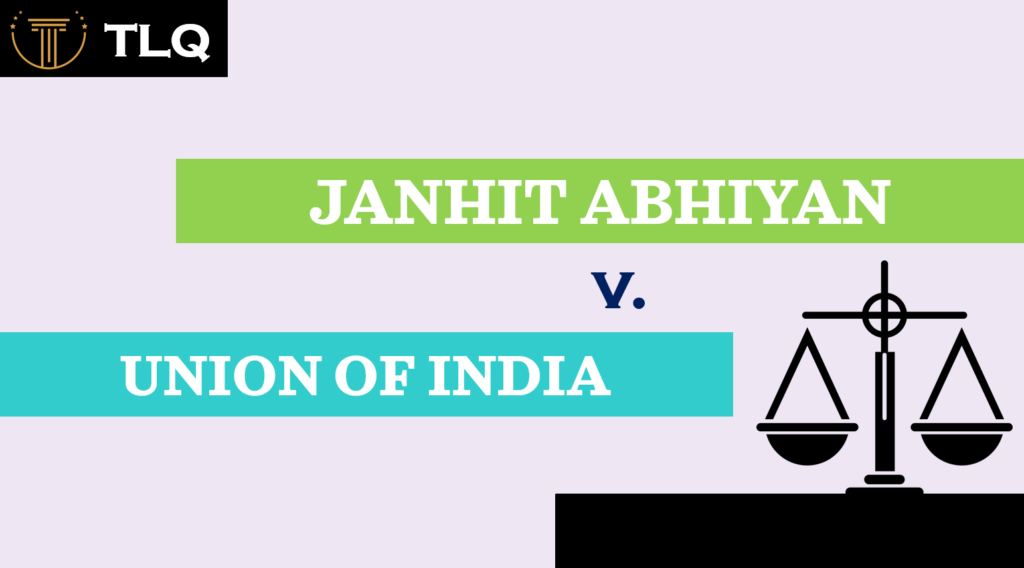Published On: 1st May, 2024

IN THE SUPREME COURT OF INDIA
CRIMINAL ORIGINAL JURISDICTION
WRIT PETITION (CRIMINAL) NO. 156 OF 2016
MAHENDER CHAWLA & ORS. ……PETITIONER(S)
VERSUS
UNION OF INDIA & ORS. ……. RESPONDENT(S)
Introduction: The Vulnerability of Witnesses
The Indian criminal justice system hinges on the crucial role of witnesses. Their testimonies act as the eyes and ears of the court, providing vital evidence to secure convictions and uphold the rule of law. However, this critical role often exposes witnesses to intimidation, threats, and violence, jeopardizing their safety and hindering the pursuit of justice. The landmark case of Mahender Chawla vs Union of India (2018) addressed this very concern, paving the way for a more robust witness protection framework in India.
The Petitioners and the Backdrop
This case involved multiple petitioners, each highlighting the vulnerability of witnesses in the Indian context. Mahender Chawla, the lead petitioner, was himself a witness who had survived a murder attempt in connection with a high-profile criminal case. Others included the father of a murdered witness and a journalist facing threats due to their investigative reporting. Notably, the case arose against the backdrop of the rape charges against Asaram Bapu and his son Narayan Sai.
The Chilling Effect of Witness Intimidation
The petitioners, through their legal representatives, argued before the Supreme Court that the lack of adequate witness protection measures created a chilling effect on the entire criminal justice system. Witnesses fearing for their lives and the safety of their families were less likely to come forward and testify truthfully. This not only hampered investigations and prosecutions but also emboldened perpetrators, leading to a cycle of impunity.
Arguments for Witness Protection
The petitioners presented compelling arguments highlighting the need for a comprehensive witness protection scheme. They emphasized that:
- Witness intimidation undermines the rule of law: When witnesses are silenced through fear, the justice delivery system is compromised. The perpetrators get away with their crimes, and public trust in the system erodes.
- Fair trial rights are jeopardized: The right to a fair trial, guaranteed under the Indian Constitution, necessitates the availability of reliable witnesses. Witness intimidation violates this right of the accused to a fair trial based on credible evidence.
- International obligations: India, as a signatory to various international human rights conventions, has obligations to protect the rights of witnesses. This includes providing them with a safe environment to participate in criminal proceedings.
The Court’s Observations and Recognition of the Problem
The Supreme Court, acknowledging the gravity of the situation, recognized the widespread prevalence of witness intimidation in India. The judgment highlighted several factors contributing to this issue, including:
- Organized crime and gang activity: Criminal organizations often resort to intimidating witnesses to ensure silence and prevent successful prosecutions.
- Social and political influence of perpetrators: In cases involving powerful or influential individuals, witnesses are more susceptible to threats and violence.
- Lack of awareness and fear of retribution: Many witnesses remain unaware of available protection measures and hesitate to seek help due to fear of retaliation.
A Turning Point: The 2016 Judgement and Paving the Way
The 2016 judgment in Mahendra Chawla vs Union of India marked a turning point. While it did not directly establish a witness protection scheme, it:
- Urged the Central Government to enact a comprehensive witness protection program: The Supreme Court emphasized the urgent need for a robust legislative framework to safeguard witnesses.
- Highlighted best practices from other countries: The judgment referenced successful witness protection models from other jurisdictions, providing valuable guidance for the Indian government.
- Directed states to take interim measures: In the absence of a formal scheme, the Court directed all states to implement interim measures to protect witnesses facing threats.
The Road to Implementation: The Witness Protection Scheme (2018)
Following the 2016 judgment, the Central Government drafted and implemented the Witness Protection Scheme (WPS) in 2018. This scheme aimed to address the concerns raised by the petitioners in the Mahender Chawla case and create a framework for safeguarding witnesses in criminal cases.
A Landmark Judgment: Approving the Witness Protection Scheme (2018)
In a significant step forward, the Supreme Court approved the Witness Protection Scheme, 2018, drafted by the Central Government. This scheme aimed to address the concerns raised by the petitioners and create a framework for safeguarding witnesses in criminal cases.
Key Features of the Witness Protection Scheme
The Witness Protection Scheme outlined various measures to ensure witness safety, including:
- Identification of witnesses under threat: The scheme established a process to identify witnesses who face potential intimidation based on the nature of the case and the perceived risk to their safety.
- Threat assessment and categorization: A mechanism for assessing the level of threat faced by each witness was put in place to ensure that appropriate protection measures were assigned.
- Protection measures: The scheme envisioned a range of protection measures depending on the threat level. This could include relocation, change of identity, security personnel deployment, and financial assistance.
- Witness identity and location protection: The scheme emphasized measures to shield the identities and locations of witnesses from potential threats.
Identification of Vulnerable Witnesses:
- Triggering Mechanisms: The WPS identifies witnesses who require protection based on various factors:
- The severity of the crime and the potential for violence against the witness.
- The perceived influence or power of the accused.
- Past instances of witness intimidation in similar cases.
- Reporting Channels: Witnesses can self-report threats to the police or court. Additionally, investigating officers, judges, or NGOs can flag potential threats based on their observations.
- Threat Assessment and Categorization:
- Threat Assessment Teams: These teams, comprising police officers, psychologists, and social workers, assess the severity of the threat faced by each witness.
- Categorization of Threats: Based on the assessment, witnesses are categorized into different threat levels (low, medium, high). This determines the type and intensity of protection measures assigned.
- Protection Measures:
The WPS offers a range of protection measures depending on the threat level:
- Low Threat: Regular police patrols near the witness’s residence, court escort services, and witness anonymity in court records.
- Medium Threat: Relocation to a safe house within the same city, temporary change of identity, and financial assistance for relocation costs.
- High Threat: Relocation to a different city with a complete change of identity, witness relocation program assistance with finding new employment and housing, witness in-custody protection during court proceedings.
- Witness Identity and Location Protection:
- Witness Anonymity: The WPS allows for witness anonymity in court records and proceedings in certain cases to shield their identity from the accused.
- Special Courts and Witness Deposition Complexes: Vulnerable witnesses can testify in special courts with physical barriers or video conferencing facilities to minimize interaction with the accused.
Challenges and Road Ahead
While the Mahender Chawla judgment and the subsequent Witness Protection Scheme were significant strides towards witness protection in India, several challenges remain:
- Effective implementation: The success of the scheme hinges on its effective implementation across all states. This requires trained personnel, adequate funding, and robust inter-agency coordination.
- Raising awareness: Raising awareness among the public, including potential witnesses, law enforcement agencies, and legal professionals, is crucial to ensure its successful utilization.
- Balancing witness protection with transparency: Striking a balance between protecting witness identities and ensuring a fair trial for the accused is an ongoing concern.
Conclusion: Mahender Chawla’s Legacy
The Enduring Legacy of Mahender Chawla: A Steppingstone Towards a Safer Justice System (Around 500 Words)
The landmark case of Mahender Chawla vs Union of India (2016) stands as a testament to the fight for witness protection in India. It brought national attention to the critical issue of witness intimidation, a problem that had long plagued the criminal justice system. While the judgment itself did not establish a formal scheme, it served as a powerful catalyst, paving the way for a more comprehensive framework to safeguard those who bravely come forward to testify.
The petitioners in the case, including a witness who survived a murder attempt and a journalist facing threats, highlighted the chilling effect of witness intimidation. Their compelling arguments exposed the vulnerability of witnesses and the detrimental impact on securing convictions and upholding the rule of law.
In response, the Supreme Court acknowledged the gravity of the situation and the need for urgent action. The judgment urged the Central Government to enact a comprehensive witness protection program. It further directed states to implement interim measures to protect witnesses facing threats. This crucial step ensured some level of immediate protection while a more permanent solution was being developed.
Following the judgment, the year 2018 witnessed the implementation of the Witness Protection Scheme (WPS). This scheme, formulated based on the concerns raised in the Mahender Chawla case, outlined a multi-pronged approach to witness safety.
The WPS establishes a framework for identifying vulnerable witnesses, categorizing threats, and assigning appropriate protection measures. These range from increased police patrolling for low-threat situations to witness relocation programs for high-threat scenarios. The scheme also emphasizes witness anonymity in court records and special court arrangements to minimize interaction with the accused.
However, the road ahead for the WPS is not without challenges. Effective implementation across diverse states requires dedicated resources, trained personnel, and robust coordination between police, judiciary, and social services. Raising public awareness about the scheme’s benefits is crucial to encourage potential witnesses to come forward and utilize its protections. Additionally, striking a balance between safeguarding witness identities and ensuring fair trials for the accused remains a delicate task.
Despite the challenges, the Mahender Chawla case and the subsequent WPS represent a significant leap forward in India’s commitment to witness protection. The case serves as a powerful reminder of the importance of protecting those who speak truth to power and contribute to a just and fair legal system. The ongoing efforts towards effective implementation and public awareness will be central to ensuring the success of the scheme and ultimately, fostering a more robust and secure criminal justice system in India.





